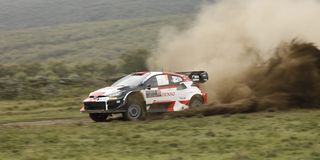Premium
Longer stages for Safari Rally could be introduced next year

France's Sebastien Ogier and his co-driver Vincent Landais compete in their Toyota Yarris at Kedong 1 stage of the 2023 WRC Safari Rally in Naivasha on June 23, 2023.
What you need to know:
- WMSC has allowed events like the Safari Rally to have longer stage distances away from the short sprint format
- These changes will be ratified in June when the next WMSC meeting takes place
- Hybrid plug-in system increases tremendous power in a Rally1 car, from 380bhp to 514bhp
The FIA World Motor Sport Council (WMSC) has allowed manufacturers to do away with the hybrid plug-in system in Rally1 cars from next year.
At the same time, WMSC has allowed events like the Safari Rally to have longer stage distances away from the short sprint format. This is certain to enhance the reputation of the Safari Rally as an endurance event.
During a meeting at the FIA headquarters in Geneva, this week, organisers were also allowed to incorporate promotions in their events such as a visit by former world champion Ott Tanak at the training camp of Olympics marathon champion Eliud Kipchoge to bring rallying closer to the people.
These are some of the significant changes recommended by a working group headed by FIA Deputy President for Sport Robert Reid and WMSC member David Richards, appointed by the FIA.
These changes will be ratified in June when the next WMSC meeting takes place.
Hybrid plug-in system increases tremendous power in a Rally1 car, from 380bhp to 514bhp.
Other members are of the WMSC are Garry Connelly, Ronan Morgan and Andrew Mallalieu as well as FIA executives Andrew Wheatley and Xavier Mestelan Pinon.
The group has put forward objectives that prioritise plans for far greater focus on public relations, marketing and promotion of the Championship, and set a framework for changes to the sporting and technical aspects of the WRC to be developed.
During the meeting chaired by President Mohammed Ben Sulayem together with FIA Deputy President for Sport Robert Reid and WMSC members, it was decided that the current Rally1 car will continue as the WRC’s flagship vehicle in 2025 and 2026.
But it will have modifications to reduce cost and performance. These include the removal of the plug-in hybrid unit, with the performance compensated by a reduction in overall weight, and a reduction in the air restrictor and aerodynamics.
“The power output will be targeted at 330bhp (from 514bhp in current Hybrid structure), with the engine performance controlled by a reference torque curve for all cars,” said the FIA in a communique.
“Engine and transmission will be cost-capped and technology limited to Rally2 equivalence. Aerodynamic efficiency will be limited along with a top speed restriction to reduce development and cost.
Discouraged manufacturers
“The cost per car will be capped at €400,000 (about Sh63.7 million) and the WRC manufacturers will be required to make their cars available for sale directly from the finish parc fermé of a WRC event.”
The present Hybrid Rally1 car costs $1 million (Sh147 million), and is one of the factors that has discouraged more manufacturers from competing in the WRC unlike in the 1990s when there was not much significant difference between Group ‘‘A’’ and ‘‘N’’ cars in cost and performance.
The Safari, regarded as one of the toughest in the calendar, will certainly benefit from competition format in which organisers can now enhance its iconic status by exploiting the endurance aspect and a flexible route design.
“The global calendar may include a small number of shorter sprint-style and longer endurance events in addition to the rallies that follow the existing format. Nevertheless, the overall timed kilometres covered during a season will remain largely unchanged with events still organised on a mix of asphalt, gravel and snow,” said FIA.
“Event organisers will be given more freedom when developing the route of their rally. However, while the starting day of an event and the number of stage kilometres can vary, all rallies should finish on a Sunday with the Power Stage.”
As part of cost-cutting measures, the target number of personnel of a three-car team will be capped in the future.




